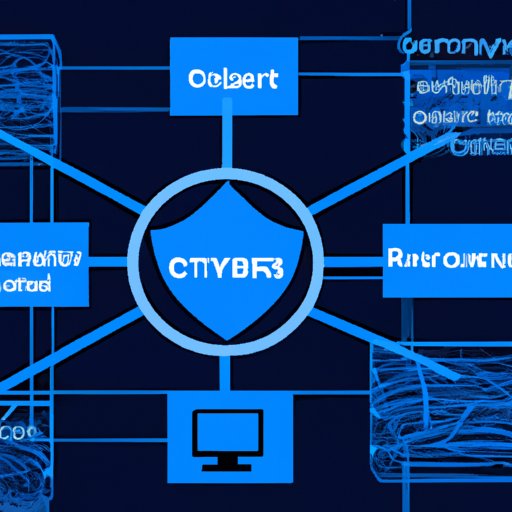Introduction
Cybersecurity is an essential part of our modern digital world. It is the practice of protecting networks, systems, and programs from digital attacks. These attacks are usually aimed at accessing, changing, or destroying sensitive information, extorting money from users, or interrupting normal business processes.
The threat of cybercrime is growing rapidly. According to a recent study by McAfee, there was a 400% increase in ransomware attacks in 2020 alone. As such, businesses of all sizes need to invest in robust cybersecurity solutions to protect their networks, data, and customers.
Exploring the Role of Cybersecurity in Protecting Networks and Data
In order to understand the importance of cybersecurity, it’s necessary to first explore the different types of security solutions available. Traditional security solutions include firewalls, antivirus software, and intrusion detection systems. Modern security solutions include artificial intelligence (AI) and machine learning (ML) technologies, which can detect and respond to threats in real-time.
No matter which type of solution is used, the primary goal is to protect networks and data from malicious actors. This includes hackers, malware authors, and other cybercriminals who seek to gain access to sensitive information or disrupt normal business operations.
A Comprehensive Guide to Cybersecurity: What It Is, Why It’s Important, and How It Works
A comprehensive cybersecurity solution should include several components. These include network security, endpoint security, application security, identity and access management, data security, and incident response. Each component works together to provide organizations with a layered approach to security that can help protect against threats.
Cybersecurity is also important because it helps organizations comply with industry regulations and protect customer data. Organizations that fail to properly secure their networks and data can face hefty fines, reputational damage, and loss of customer trust.

Understanding the Different Types of Cybersecurity Solutions
When it comes to protecting networks and data, there are several types of cybersecurity solutions available. Traditional solutions such as firewalls and antivirus software can help protect against known threats. However, they may not be enough to protect against more advanced threats.
Modern solutions such as AI and ML technologies are becoming increasingly popular. These solutions can detect and respond to threats in real-time, helping organizations stay ahead of cybercriminals and protect their networks and data.
Examining the Growing Threats of Cybercrime and How Cybersecurity Can Help
Cybercrime is a growing threat that can have serious consequences for businesses. According to a recent study by Accenture, the average cost of a data breach is estimated to be over $3 million. Furthermore, cyberattacks can lead to stolen customer data, intellectual property theft, and disruption of business operations.
Fortunately, cybersecurity solutions can help protect against cyber threats. By implementing robust security solutions, organizations can reduce the risk of being targeted by cybercriminals and mitigate the potential impacts of a successful attack.

Exploring the Benefits of Investing in Cybersecurity
Investing in cybersecurity can offer numerous financial and operational benefits. For example, having a robust cybersecurity program in place can help organizations save money by reducing the risk of costly data breaches. Furthermore, it can help businesses stay competitive by ensuring their networks and data remain secure.
Additionally, having a comprehensive cybersecurity program in place can boost customer confidence and strengthen customer relationships. This is especially true for organizations that handle sensitive customer data, such as financial institutions.

The Future of Cybersecurity: What We Can Expect
The future of cybersecurity looks bright. As cyber threats continue to evolve, so too will the solutions used to protect networks and data. Artificial intelligence and machine learning technologies are expected to play a major role in the future of cybersecurity, as these technologies can detect and respond to threats in real-time.
Furthermore, the use of cloud computing and Internet of Things (IoT) devices is expected to rise, creating new opportunities and challenges for cybersecurity professionals. It is therefore essential that organizations invest in robust security solutions to protect their networks and data.
Conclusion
Cybersecurity is an essential component of our modern digital world. It is the practice of protecting networks, systems, and programs from digital attacks. In order to protect against cyber threats, organizations must invest in robust security solutions and have a layered approach to security.
Moreover, investing in cybersecurity can offer numerous financial and operational benefits. It can help organizations save money, stay competitive, and strengthen customer relationships. As such, it is essential for organizations of all sizes to invest in comprehensive cybersecurity solutions.
(Note: Is this article not meeting your expectations? Do you have knowledge or insights to share? Unlock new opportunities and expand your reach by joining our authors team. Click Registration to join us and share your expertise with our readers.)
